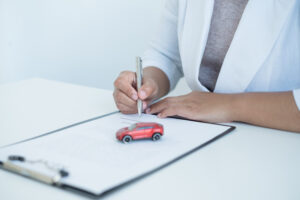What Steps Should I Take After a Hit-and-Run Accident?
In California, drivers must provide “reasonable assistance” to anyone they involve in an accident; this is especially true where there’s a personal injury. Even if drivers leave the scene of the car accident to obtain medical help, they should still leave behind their contact information and insurance information, to be on the safe side. Otherwise, they may be accused of causing a hit-and-run accident.
This refers to any car accident where a driver leaves the scene without giving the other party his or her contact information. It implies guilt, can open the driver to criminal charges, and make him or her at fault and thus responsible for the injured party’s financial and other losses.
You Have Options for Moving Forward
As the victim of a hit-and-run, you may be wondering just how you can seek compensation; after all, you may be unable to seek it from the other party’s insurance company. A personal injury attorney can confidently tell you, though, that you have options. The following are a few essential steps you can and should take.
Identifying the Other Driver
First, identifying the other driver is not entirely out of the question. Any information you relay will help the police in their search for the suspect. This includes the vehicle’s make and model, color, and license plate number (even if it’s not the whole number) as well as any details about the driver’s appearance. The police can also gather any eyewitnesses and consult any security camera footage of the crash.
Immediately after an accident, you want to take photographs of the damage and record what items in particular were damaged: not just the vehicle but also, for example, any costly electronic equipment like phones and laptops. In addition, write down what happened. This is especially important because you may need to move your vehicle out of the way of traffic, making the task of recalling certain details harder.
If there’s any evidence that the other driver inadvertently left behind, collect it. It could be something as small as a flake of paint from that driver’s vehicle, but it will no doubt facilitate the police search.
Getting Immediate Medical Attention
Another priority is to get immediate medical attention. Chances are that you already did this or someone on the scene phoned for an ambulance. Even if you call your accident relatively minor, that should not stop you from scheduling a medical check-up. These are just a few injuries that often remain hidden until days after the incident:
- Minor traumatic brain injuries (concussions)
- Abdominal trauma
- Soft tissue injuries like whiplash
- Neck, shoulder, and back conditions
The sooner you’re examined, the earlier the doctor can catch these conditions and the more effectively he or she can treat them. Don’t ignore the normal symptoms, such as headache, if they persist. Chronic headaches may point to a blood clot. Concussions, in particular, can leave you with long-term cognitive impairment if left untreated; you may have speech, vision, and hearing problems and experience clouded thinking and trouble remembering things.
By getting immediate medical attention, you’ll get good advice on monitoring your symptoms, which will help flesh out any injury claim that you file later on.
Filing a Claim with Your Insurance Company
So by this point, you should generally know what your losses are in terms of both property damage and personal injury. Filing a personal injury claim will be the next step, and this is where a lawyer comes in. Make sure to act before the statute of limitations runs out, too. In this state, you have two years to file a claim involving personal injury and three years for a claim involving property damage.
If, when all is said and done, you never identify the other driver, don’t worry; you can file a claim with your own insurance company. Uninsured motorist insurance can cover medical bills but not property damage (unless you identify the other driver). Collision coverage can cover vehicle repairs, but the downside is that you pay the deductible (unless, again, you identify the other driver). Both types of coverage are optional in California, as you know, so not everyone can go this route.
Unfortunately, there’s no other choice in the absence of the other driver; one positive is that your insurance rate will not go up, provided you file your claim within a reasonable amount of time. But let’s say that you do identify the one who is at fault. You could then proceed with a third-party insurance claim. This will open the doors to you being covered for every economic and non-economic loss.
The Compensation You Could Receive
To know how much you could receive in compensation, you would need to take into account the state’s pure comparative negligence rule. Under this rule, every driver who contributes to an accident will be responsible for his or her share of the blame and so be eligible for less compensation the higher his or her degree of fault.
If, for instance, you contributed 20% to the accident by failing to wear a seatbelt or signal a turn, then you could still have a strong case since the other driver carries 80% of the blame. But the amount you recover will literally be reduced by 20%. On the other hand, since California follows a pure comparative negligence rule, nothing bars you from trying to file a claim if you were, say, 50% or even 60% at fault. Obviously, the chances of recovering damages become slimmer the higher the degree of fault.
Let’s see now what damages you could receive. Most fall under what’s called compensatory damages: damages that reimburse you for both economic and non-economic loss.
Compensatory Damages
A personal injury attorney could help you calculate all of your losses, including those that don’t necessarily come with a dollar amount (non-economic). Losses can include:
- Vehicle and other property damage
- Past and future medical bills
- Lost wages and future lost income
- Pain and suffering and emotional distress
Check your insurance plan to see if you have rental reimbursement coverage; this will cover the cost of renting a car while your vehicle is being repaired.
Medical expenses can encompass more than one-time treatments and surgeries. There’s the cost of taking an ambulance, driving back and forth for doctor appointments, getting prescription medications, undergoing physical therapy, and so on. Victims with catastrophic injuries can be covered for equipment like walkers and wheelchairs as well as any necessary home modifications or in-home nursing care.
If your injuries prevent you from working at the same capacity as before, then your claim can reflect this; it’s called lost earning capacity.
Pain and suffering and emotional distress are non-economic damages, but they are not less real for all that. Many times, hit-and-run accidents can cause victims to suffer from post-traumatic stress disorder. They may suffer from great anxiety triggered by life changes like loss of employment and loss of mobility, and this could cause estrangement in relationships. Under this state’s personal injury law, you could be compensated for this loss, called loss of consortium.
Punitive Damages
Lastly, in rare cases, and only in third-party insurance claims, victims may be able to seek punitive damages. The goal in seeking punitive damages is not to restore any legitimate loss but rather to punish the defendant and deter him or her from such actions in the future. Punitive damages are awarded only in cases where the defendant clearly acted in a reckless or malicious way, such as in cases of road rage.
Keep in mind that your case falls under civil law and will have no connection to any criminal proceedings that the defendant might undergo. It’s good to know, though, that in California, hit-and-run accidents that result in property damage are considered misdemeanors. Those resulting in injury or death can be felonies.
Contact a Personal Injury Attorney
If you’re ready to see if you can file a personal injury claim, contact JT Legal Group today. The consultation will be free of charge, and you won’t need to feel obligated to hire us. Let us protect your rights at every step.



